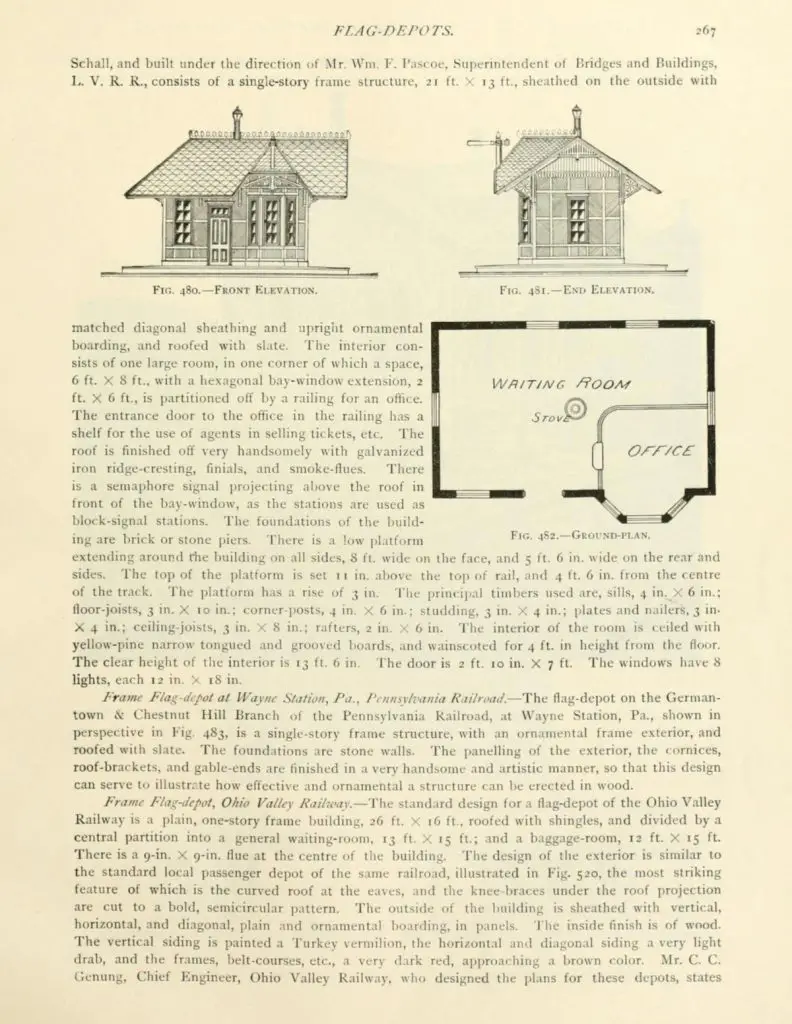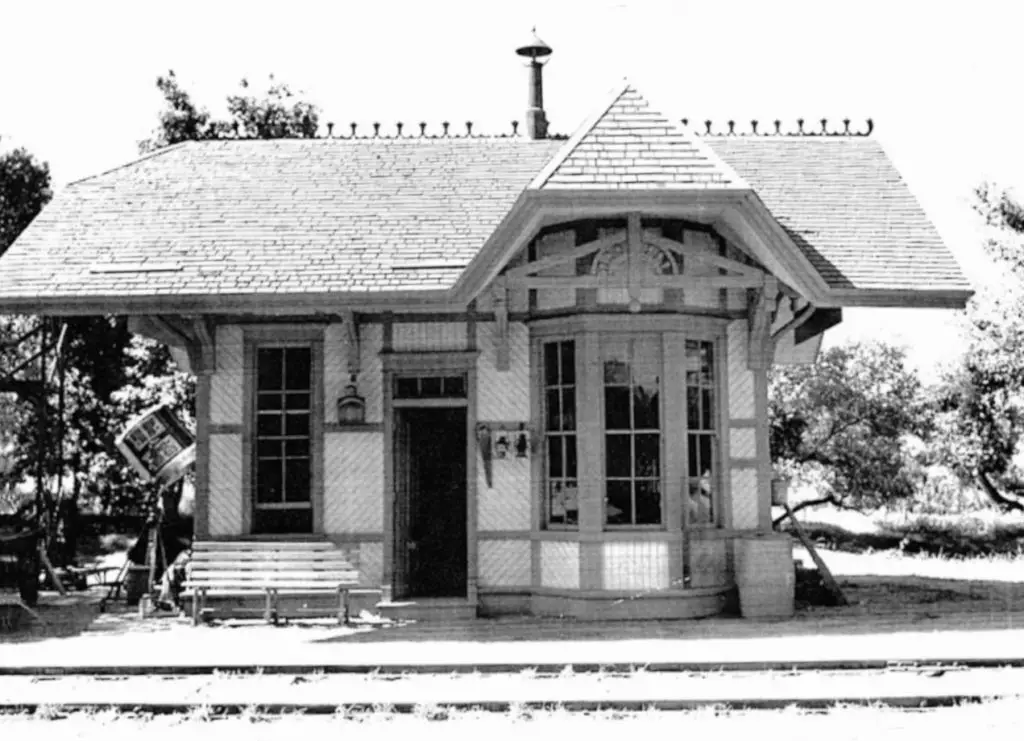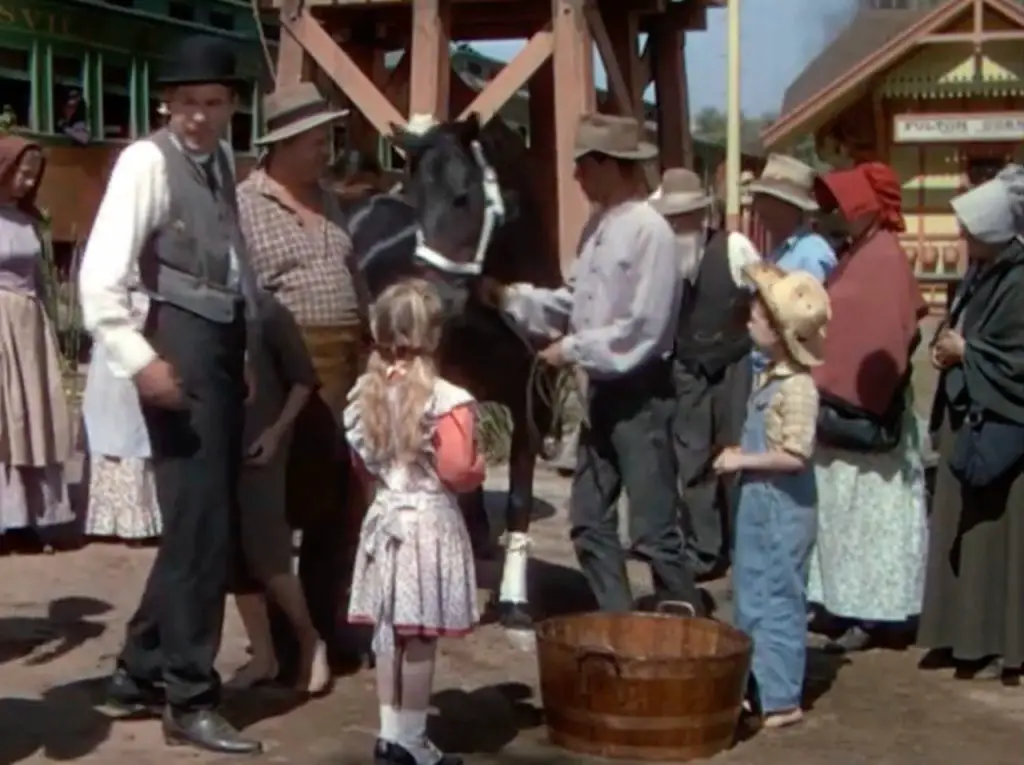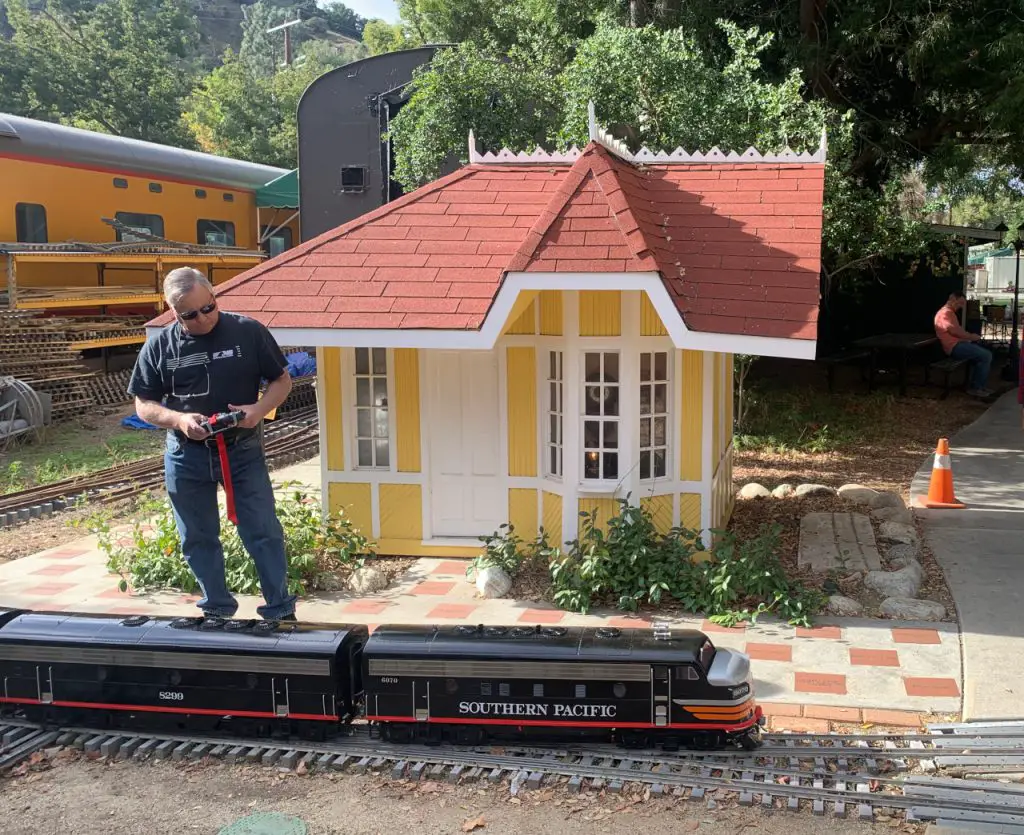It is unlikely that guests patiently waiting for the Disneyland Railroad at New Orleans Square are aware that they are gazing across the tracks at a piece of Disney history that, in its own way, pre-dates Disneyland. You could even say its origin pre-dates Walt Disney himself. It is that station across the tracks, which is a replica… of a replica… of a historic depot that has long since disappeared.
Perhaps it is best to begin this story at the beginning.

In 1946, Walt Disney was making preparations to film his first full-length live-action movie. The source material was a Sterling North book entitled Midnight and Jeremiah, which Walt had acquired the year it was published, 1943. Walt felt strongly about the book, as the story resonated with his own childhood days in Missouri. Set in Fulton Corners, Indiana in 1903, it told of a young boy named Jeremiah Kincaid, and his dream of entering his beloved black lamb Danny in the County Fair.
Walt’s version of the story added an opening scene in which a steam train pulls up to the community’s little depot. As young Jeremiah watches in amazement, the great racing horse Dan Patch is brought out of his special car to be exercised, and have a worrisome nail extracted from his shoe.
A filming location for the crossroads community of Fulton Corners had been chosen just outside Visalia, California. This was about halfway between Bakersfield and Fresno. The Southern Pacific railway tracks still ran through town, though passenger service had been discontinued in 1940. The town’s abandoned depot was deemed too large for the purposes of the film. Besides, it was in California Mission style, wholly inappropriate for Pike County, Indiana.
For the scene, Walt knew he would need to build an appropriate depot. He turned to animator Ward Kimball, who had a special interest in early railroading. According to most sources, Ward found the right design in an 1893 book from his library, Buildings and Structures of American Railroads.

According to the book, the tiny structure, a Flag Stop Depot, had been used in the Pottsville Branch of the Lehigh Valley Railroad in Pennsylvania. The book included a front elevation, side elevation, and a simple floor plan.

It should be noted that the same station had clearly inspired an item in the December 1946 issue of Model Railroader Magazine. The one-page article was entitled Whistle Stop. The neatly drawn elevations that were included were identical to those in the older book. Could this be the document that Ward delivered to Walt?


Regardless of the source, there is no denying that the little Fulton Corners depot was faithful to the original drawings in nearly every detail. Interestingly, the original Lehigh Valley Railroad depot has long since disappeared. There are no extant photos of it, and no one is even certain where it may have been located.

The depot in Visalia was a typical movie set. Only the front, side walls and roof had been constructed, as only these would be visible on camera. The building was also held up with simple framing and lacked a foundation. After all, it would be needed for only a few days of filming.


Strangely, after all the time and effort to create the depot, it is barely visible in the film. In the opening scene just the front bay window and elaborate brackets can be seen as the train pulls into view. As people gather to admire Dan Patch, the side of the station can be glimpsed behind the crowd.

A section of it can be seen during the film’s final scene, as Jeremiah and his lamb Danny return from the Pike County Fair. It is visible behind Mr. Grundy, as he invites everyone to come and join a celebration at his store.

The only time the entire depot can be seen is during a scene midway through the film. It is just visible through the door of Mr. Grundy’s store.
After the location shooting was done, The set was presented to Ward Kimball. Walt knew that Ward had a live steam train on his property in San Gabriel, and thought the station would be a good addition. As grateful as he was for the gift, Ward found he had accepted something of a “pig in a poke.” The set pieces that were trucked to his house did not arrive with any instructions for reassembly. But where there’s a will, there’s a way, and Ward doggedly proceeded to piece the building together. Unfortunately, placing the roof on top of the cobbled-together structure caused it to collapse.

But Ward was determined, and after a fresh start, including a foundation and other new construction, the little station was complete. With a new nameplate reading “Grizzly Flats” (Ward’s fanciful name for his 900-foot backyard “railroad”), the little depot was later joined by other structures, including a water tank, roundhouse, and windmill. Ward enjoyed weekend steam-up parties for friends, co-workers, and neighbors.
Walt Disney attended some of these parties, and in 1950 determined to build his own backyard railroad. Walt’s Carolwood Pacific was to be a miniature railroad, which would give him greater variety in the operation. (Ward’s train was simply driven forward and backward on the 500-foot main line.) Walt had seen a miniature layout in the backyard of another Disney animator, Ollie Johnston.
After spending his own pleasant weekends entertaining guests from 1950 to 1953, Walt decided he would build a bigger train, in a bigger location, and offer it to the public. This, of course, became Disneyland. As the July, 1955 opening date approached, Walt found himself strapped for cash and time. He intended to offer two train rides on the track that encircled the park. The passenger train would operate from Main Street, and the freight train from Frontierland. There was just one problem: he needed a station for the Frontierland departures.
Different versions have been told of the afternoon that Walt Disney called Ward Kimball into his office to ask him to “return” the set piece he had “loaned” him. Whatever the actual response, the result was the same. Ward kept the original So Dear to my Heart depot, and Walt had to content himself by building a close copy.


This station was placed on the public side of the tracks, and was fully functional, serving as a ticket booth for the attraction. There were a few minor changes. Instead of a single door, there were double doors to handle the crowd. The station was also built with a bay window and doors on each side, so it would show its “best face” to the public approaching from either direction.

This is the same train station that can be seen in New Orleans Square today. It has been rotated to match the elevation of the original So Dear to My Heart station, and it includes a pair of covered platforms at each end, which had been added before the move. Today it is inaccessible to the public, serving as a visual marquee for the New Orleans Square/Frontierland railroad platform.

Interestingly, there is another little depot in Disneyland that appears to have been inspired by that same Lehigh Valley Railroad Flag Stop Depot. It is in Fantasyland, where designer Bruce Bushman was tasked with providing an appropriate ticket booth for the Casey Jr. Circus Train attraction.

This little depot can still be found on the Casey Jr. platform. Look closely, and you will see that the design is a whimsically stylized version of the original.

And there is at least one other smaller version of the same depot with a Disney railroad connection. Guests visiting Walt Disney’s Carolwood barn at the Los Angeles Live Steamers Railroad Museum in Griffith Park will find Ollie Johnston’s La Canada Valley Railroad station on display. It is undeniably inspired by the same design.

When it was completed in 1950, Ollie chose to feature it on the family Christmas card that year, complete with his two sons ready for a trip to the North Pole. T.hat summer Walt was a guest at Ollie’s steam up parties and likely would have recognized the depot design.


Ollie’s depot remained in place and in use for many years. In 1994, Ollie posed with it in his backyard, and in 2001 a volunteer work crew did the same. After Ollie moved to Washington state to live with family members, the depot was carefully dismantled and moved to the Carolwood compound.

Ollie Johnston passed away in April 2008, at the age of 95. A month later, his backyard depot was dedicated by the Carolwood Foundation, with family members and friends in attendance. It is still on public display.
But what of that original So Dear to My Heart set piece that had been moved to Ward Kimball’s backyard in 1947?

Ward officially retired from Disney in 1973, although he did remain available as a consultant. One of his active hobbies in his remaining years was the Grizzly Flats Railroad. In 1978 Tom Snyder of NBC’s Tomorrow Show joined Ward in his backyard. (Tom is behind the hand cart in the still frame from that program.)

Before Ward’s death in 2002, he had donated his beloved Emma Nevada engine and some of his rolling stock to the Southern California Railroad Museum (formerly Orange Empire Railway Museum). The family continued operating the Grizzly Flats through 2006. The depot was offered to the SCRM, but they declined, feeling the former movie set was too fragile.

But that is not the end of the story. In a twist worthy of a Hollywood screenplay, the former Fulton Corners/Grizzly Flats depot was moved yet again, this time all the way up to the Sonoma Valley. John and Nancy Lasseter had a family winery there, and a narrow gauge railroad. John had purchased the engine and rolling stock from Ollie Johnston, who had operated them as his Deer Lake Park and Julian Railroad on vacation property north of San Diego.

So it was, starting in 2007, that Ollie Johnston’s narrow gauge train would pull up to Ward Kimball’s depot which had been Walt Disney’s movie set at John Lasseter’s Justi Creek Railroad. Now there’s a happy Hollywood ending!
But sadly, this ending was not to be. In the fall of 2017, wildfires raged throughout the Sonoma Valley, and several historic wineries were in their path. One victim of the fires was the tiny Justi Creek Railroad depot. The building and its contents were completely destroyed.
The loss of this humble little building was unfortunate. But consider this. The original Lehigh Valley Flag Stop Depot has never been located. There are no photographs of it, and no one is even certain where it may have been located or how long it existed. The depot constructed for So Dear to My Heart was intended to be used for only a matter of a few days of film shooting, and then to be dismantled and forgotten. But it had been in continuous use for over seventy years, bringing pleasure and enjoyment to thousands of people. The structures it inspired are still in use today. So hold on to that happy ending.

